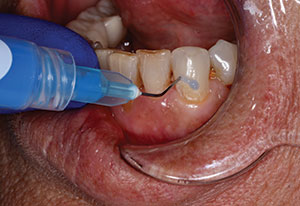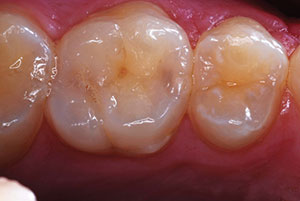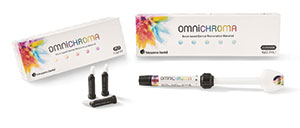INTRODUCTION
A Brief Review of the PFM Restoration
Used for more than 60 years, PFM restorations provide a functional and stable treatment option.1 While there is variance in the aesthetic quality and longevity of these restorations, they have been proven to be successful.2 Some of the disadvantages of PFM restorations include the significant amount of tooth structure required with preparations to achieve proper aesthetics and resistance-retention form. Some other disadvantages involve the metal substructure hiding dental caries underneath the restorations, limiting diagnostic capabilities.3 Fractures and/or chips in the veneering porcelain material can decrease PFM function and shorten the lifespans of these restorations.4-6
Decreased aesthetics remains the most common patient complaint regarding PFM restorations. Black lines at the margin due to metal oxidation and/or receding gums significantly detract from aesthetics. The unsightly dark margins of PFM crowns, even with porcelain margins, can also occur because the metal copings prevent light from shining through the crown and into the root, creating a shadowing effect.3 Especially troublesome in the anterior region, PFM restorations have difficulty achieving an aesthetic appearance with adjacent natural dentition because of the metal/ceramic combination.7,8 Additionally, opaque PFM restorations limit their ability to blend with underlying tooth structure, especially when compared to other metal-free options that can achieve more natural aesthetics.3
 |
 |
| Figure 1. Preoperative view of the patient’s natural smile. | Figure 2. Retracted preoperative full-mouth view. Note the discoloration around the PFM margins. Also, discrepancies in tooth length and gingival heights of contour made the teeth look unnatural and unbalanced. |
 |
| Figure 3. Retracted preoperative full-facial view of the patient’s dentition. |
For aesthetic purposes, the metal copings require that PFM crown margins be placed subgingivally.2,3 However, the impression of a subgingival margin for a PFM restoration continues to be one of the most challenging procedures in dentistry.1 Due to the use of retraction cords and subgingival extension of the margins, the surrounding tissue is often disturbed.3 Although any subgingival margin will irritate the periodontium, a poor-fitting margin can drastically decrease periodontal health.9-11
In addition to gingival and periodontal compromise, more aggressive tooth preparation is routinely necessary for PFM restorations. PFM restorations require removal of healthy tooth structure to create axial walls for resistance-retention form, and one in vitro study found that 67.5% to 75% coronal tooth structure removal was necessary for complete full PFM crowns.12 This reduction in tooth substance provides the basis for a predictable PFM restoration, but also increases the risk of irreversible damage to the pulp.13
When PFM restorations fail, challenges may arise when determining a new restorative treatment plan. Intense preparation techniques, decay, and microleakage contribute to the damaged teeth found underneath failed PFM restorations. These teeth may require buildups prior to new restorations, using composite materials to bond to dentin if necessary. In order to ensure strength while conserving tooth structure, dentists need to assess the amount of enamel and dentin exposed. Determining what the substrate will be bonded to assists in establishing the treatment plan with the ideal amount of buildup and material thickness.
Advantages of Metal-Free Options
Unlike PFM restorations, metal-free materials require managing discolored underlying tooth structure in order to create aesthetic restorations. Shade matching of prepared teeth and using a material that offers different levels of opacity to mask blemishes enables fabrication of restorations that look natural and highly aesthetic. Simutaneously, a patient’s personal functional goals and aesthetic desires can be difficult to achieve if the individual’s clinical situation also involves uneven gingival heights of contour. Therefore, it becomes necessary for clinicians to know and understand what is clinically possible, as well as what materials and techniques can be incorporated to deliver an appropriate treatment. Understanding material strength, aesthetic properties, and material preparation requirements enables dentists to combine the ideal final restoration with other procedures to achieve a patient’s expectations.
While PFM restorations may lack high aesthetics and tooth structure conservation, the unique strength that they provide makes selecting an alternative challenging. Now, new materials have been developed that match the strength that PFM restorations provide. Although longevity of some new materials presents a concern for some, these highly aesthetic materials typically require minimal preparation and less invasive treatment of the surrounding periodontium compared to PFM restorations, which suggests that the tooth itself will remain healthier for a longer period of time.
One of these recently developed materials, lithium disilicate (IPS e.max [Ivoclar Vivadent]), is very strong and yet highly aesthetic. Its unique glass-ceramic composition refracts light naturally, increasing the lifelike aesthetics of a restoration.14 With a flexural strength of 360 MPa (CAD/CAM) to 400 MPa (pressed), lithium disilicate meets the necessary strength demand for all indications.14,15 Lithium disilicate requires minimal tooth preparation compared to conventional full-coverage PFM crowns and significantly decreases the risk of pulpal damage.15 Avaiable in a variety of ingots, lithium disilicate allows ceramists to create beautiful restorations that cover and mask underlying tooth structure in an aesthetic way.16
CASE REPORT
Diagnosis and Treatment Planning
A 64-year-old male patient presented with old and failing anterior PFM crowns, with porcelain cracking and recurrent decay (Figure 1). His main concerns were function, the carious lesions, and the desire for a predictable and strong restorative material. He did not want a smile makeover and asked to keep the number of restorations to a minimum. He also presented with uneven gingival architecture and non-ideal tooth shape and form (Figures 2 and 3). Teeth were bulbous in contour, and the axial inclinations were improper (Figures 4 and 5). He also exhibited a midline cant, and the tooth/restoration color was flat, opaque, unnatural, and did not blend with his natural dentition.
 |
 |
| Figure 4. Preoperative retracted right lateral view. | Figure 5. Preoperative retracted left lateral view. |
 |
 |
| Figure 6. A stick bite was taken. | Figure 7. The Kois Dento-Facial Analyzer (Panadent) was used to transfer the patient’s maxillary occlusal plane. |
 |
 |
| Figure 8. The wax-up model demonstrated the new smile design. | Figure 9. After immediate removal of existing crowns, overly tapered preparations with recurrent decay around the margins were revealed. |
 |
 |
| Figure 10. View of the tooth preparations after decay removed, composite buildups completed, and shade taken. | Figure 11. Provisionals show improved gingival heights of contour and tooth form. |
 |
| Figure 12. Retracted full-mouth view with the provisional in place. |
The restorative plan included replacing the PFM crowns with high-strength lithium disilicate (IPS e.max). This strong and aesthetic metal-free choice (with a large selection of different color ingot choices, opacities, and translucencies) would enable minimally invasive techniques.
A 3-unit bridge on teeth Nos. 9 to 11 was avoided to keep the treatment as conservative as possible. Placing a cantilever off tooth No. 9 was an option, but tooth No. 9 had been previously prepared, leaving the restorations mostly bonded to dentin. Bonding to enamel would provide the greatest strength possible, so it was decided to cantilever from the canine, with virtually no preparation on tooth No. 11 and mostly to remove mesial demineralization.
Such a conservative cantilever with high aesthetics would not have been possible with a PFM restoration. In this case, a wider connector masked the cantilever, since it was distal to the pontic on No. 10 instead of No. 9. A PFM bridge would have required either a fully prepared tooth No. 11 with a cantilever like the patient currently had, or a cantilever off the canine with a metal wing.
In this case, the metal wing would have interfered with occlusion, and preparation of the lingual would have been necessary. Using the all-ceramic lithium disilicate material allowed a conservative treatment with minimal additional preparation.
The records appointment involved a face-bow, photographs, and detailed documentation for correcting cant, shapes, and contours (Figures 6 and 7). The laboratory team (Brad Patrick, Patrick Dental Studio; Bend, Ore) provided a diagnostic wax-up based upon the patient’s specifications (Figure 8).
Clinical Protocol: Preparations and Provisionals
A gingivectomy was performed on tooth No. 8 to raise the gingival margin to match tooth No. 9. The patient had deficient bone and tissue in the area of tooth No. 10, so no tissue preparation was needed because the plan involved making a hygienic style pontic. A surgical blade was used to cut the tissue back to the ideal height, and then bone was sounded to ensure there was no violation of biologic width.17
Once the existing crowns were removed, the marginal leakage and resulting caries were evident (Figure 9). After removing the decay, the teeth were built up to the ideal form with composite. The preparation shades were photographically captured to ensure proper communication of the underlying tooth color to the laboratory. The desired final shade for the laboratory ingot selection was noted (Figure 10).
The provisional restorations were placed and produced ideal tooth and tissue form with excellent aesthetics (Figures 11 to 13). When the patient returned for evaluation, the tissue health was determined to be ideal. The patient’s smile improved with a very minimal number of restorations. The shade was taken to match the surrounding dentition (Figure 14) and forwarded to the laboratory team for fabrication of the lithium disilicate (IPS e.max) restorations.
 |
 |
| Figure 13. Provisionals were evaluated in the patient’s full smile. | Figure 14. Shades were taken to match the definitive restorations to the provisional restorations. |
 |
 |
| Figure 15. Retracted close-up postoperative view of the maxillary anterior restoration. | Figure 16. Retracted right lateral postoperative view of the restorations. |
 |
 |
| Figure 17. Right lateral postoperative view of the patient in natural smile. | Figure 18. Left lateral postoperative view of the patient in natural smile. |
 |
 |
| Figure 19. Facial postoperative view of the patient’s natural smile showing full arch. | Figure 20. Close-up facial postoperative view of the patient’s natural smile. The definitive lithium disilicate (IPS e.max [Ivoclar Vivadent]) restorations exhibited a natural blend with existing dentition. |
Cementation of the Final Restorations
At the delivery appointment, the patient was anesthetized, the provisional restorations removed, and the preparations were cleaned and dried. The patient’s lithium disilicate (IPS e.max) restorations were tried-in to confirm fit. Upon removal, the restorations were rinsed with water spray and dried with oil-free air. Next, a cleaning paste (Ivoclean [Ivoclar Vivadent]) was applied with a microbrush to the internal aspects of the restorations and left in place for 20 seconds. Then, the restorations were rinsed again with water spray and dried with oil-free air. A universal primer (Monobond Plus [Ivoclar Vivadent]) was then applied to the cleaned restoration surfaces and allowed to react for 60 seconds. Excess primer was dispersed with a stream of oil-free air.
The tooth preparations were cleansed with 27-µm aluminous oxide with a 0.015 tip at 40 psi. Then, the preparations were etched, rinsed, and lightly dried. Next, a resin adhesive (ExciTE F [Ivoclar Vivadent]) was applied to the preparations, agitated for 20 seconds, then air-thinned and light cured.
A universal resin cement (Variolink II [Ivoclar Vivadent]) was then mixed with equal parts of low viscosity catalyst/base and applied to the restorations. The restorations were seated with light finger pressure, and gross excess cement was removed with a rubber tip stimulator. The restorations were then cured with a quarter-cure technique from the mesial and distal aspects of the facial and lingual surfaces. A scaler was used to remove excess cement, and floss was passed through the contacts to ensure that no cement adhered to the other teeth. The restorations were then light cured on all surfaces. Finally, the occlusion was checked and adjusted as needed.
The final restorations delivered strength and beauty while satisfying the patient’s main goal of function. The treatment exceeded his expectations, with regard to what he thought his smile could look like (Figures 15 and 16), and he was amazed that such a minimal amount of dentistry could transform his smile (Figures 17 to 20).
CLOSING COMMENTS
Although PFM restorations have provided the desired strength for many indications, there are limitations in their capability of challenging aesthetics and tooth preparation requirements. With lithium disilicate, dentists and ceramists now have an excellent aesthetic and functional restorative alternative. As shown in the clinical case presented herein, it works exceptionally well when minimally invasive treatment is indicated, and possesses the physical and nature-like optical properties that will routinely surpass the patients’ and dentists’ expectations.
References
- Christensen GJ. Porcelain-fused-to-metal vs. nonmetal crowns. J Am Dent Assoc. 1999;130:409-411.
- Ruiz JL. Anterior and posterior partial-coverage indirect restorations using supragingival dentistry techniques. J Mass Dent Soc. 2012;61:16-19.
- Ruiz JL, Christensen GJ. Rationale for the utilization of bonded nonmetal onlays as an alternative to PFM crowns. Dent Today. 2006;25:80-83.
- Ozcan M. Fracture reasons in ceramic-fused-to-metal restorations. J Oral Rehabil. 2003;30:265-269.
- Burke FJ, Ali A, Palin WM. Zirconia-based all-ceramic crowns and bridges: three case reports. Dent Update. 2006;33:401-410.
- Kugel G, Perry RD, Aboushala A. Restoring anterior maxillary dentition using alumina- and zirconia-based CAD/CAM restorations. Compend Contin Educ Dent. 2003;24:569-576.
- Wall JG, Cipra DL. Alternative crown systems. Is the metal-ceramic crown always the restoration of choice? Dent Clin North Am. 1992;36:765-782.
- DiTolla MC. A new metal-free alternative for single- and multiunit restorations. Compend Contin Educ Dent. 2002;23(9 suppl 1):25-33.
- Larato DC. Effect of cervical margins on gingiva. J Calif Dent Assoc. 1969;45:19-22.
- Silness J. Periodontal conditions in patients treated with dental bridges. J Periodontal Res. 1970;5:60-68.
- Smith DC, Williams DF, eds. Biocompatibility of Dental Materials. Boca Raton, FL: CRC Press; 1982:65.
- Edelhoff D, Sorensen JA. Tooth structure removal associated with various preparation designs for posterior teeth. Int J Periodontics Restorative Dent. 2002;22:241-249.
- Bishop K, Briggs P, Kelleher M. Margin design for porcelain fused to metal restorations which extend onto the root. Br Dent J. 1996;180:177-184.
- Ivoclar Vivadent. IPS e.max Lithium Disilicate: The Future of All-Ceramic Dentistry—Material Science, Practical Applications, Keys to Success. Amherst, NY: Ivoclar Vivadent; 2009:1-15.
- Terry DA, Leinfelder KF, Geller W, eds. Aesthetic and Restorative Dentistry: Material Selection and Technique. Chicago, IL: Quintessence Publishing; 2009.
- Culp L, McLaren EA. Lithium disilicate: the restorative material of multiple options. Compend Contin Educ Dent. 2010;31:716-725.
- Kois JC. Altering gingival levels: the restorative connection part I: biologic variables. J Esthet Restor Dent. 1994;6:3-7.
Dr. Seay maintains a private practice in Mount Pleasant, SC, and is an accredited member of the Academy of Cosmetic Dentistry. Since graduating from New York University College of Dentistry in 2002, she has continued to expand her base of dental knowledge and skills through continuing education and advanced training. Sharing her knowledge as a Kois Clinical Instructor in Seattle, she has also published articles covering the art and techniques of aesthetic dentistry and serves on the boards of several peer-reviewed journals. She was nominated as one the “Top 25 Women in Dentistry” in 2012. She can be reached at (843) 375-0395 or seayamanda@gmail.com.
Disclosure: Dr. Seay is a key opinion leader for Ivoclar Vivadent.











